Warnings in the Amusement Industry
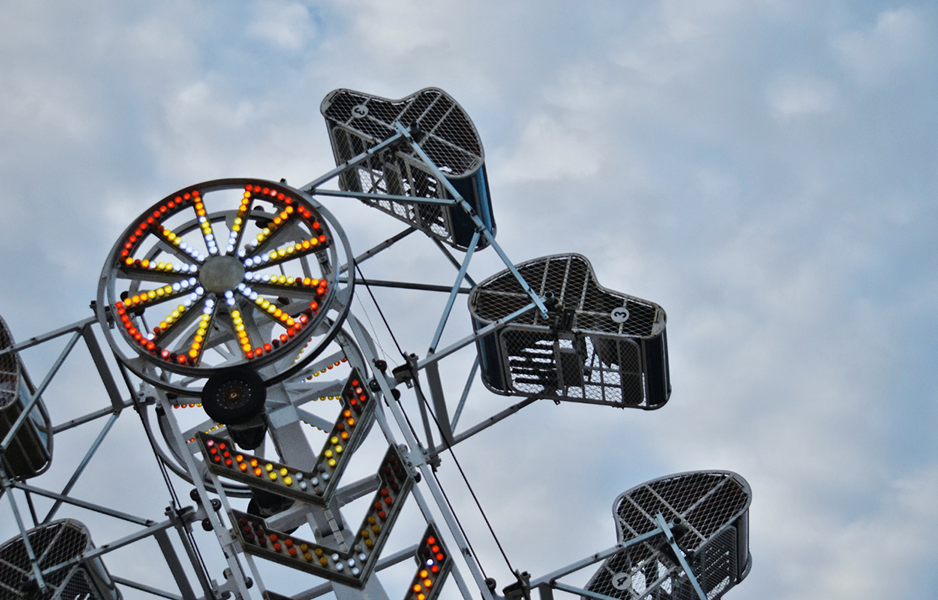
This article was previously featured in “Expertly Speaking”. Click here to access the full digital edition.
Consensus standards for safety and warning signs are found in the American National Standards Institute (ANSI) Z535 series, which includes six values regarding “the design, application, and use of signs, colors, and symbols intended to identify and warn against specific hazards and for other accident prevention purposes”.¹ This study aims to compare these established standards regarding effective warning signs with the requirements for signage found in American Society for Testing and Materials (ASTM) International standards for the amusement industry.
Subject Matter Research
Human factors research into the effectiveness of warnings has concluded that many warnings are ineffective at causing people to avoid behaviors that are discouraged by warning signs.² While there are ways to improve the effectiveness of warnings, no warning is 100% effective.³ The effectiveness of a warning sign influencing a patron’s behavior depends upon a number of factors: (1.) whether the patron reads the sign, (2.) whether they understand its message, (3.) whether they remember the warning when the time comes to take the right action, and (4.) what they believe about the costs of complying versus the risks of not complying.⁴
More important than warning signage, good safety practices include a hazards control hierarchy in which hazards are first eliminated to the extent possible, followed by engineering controls such as guards, and finally administrative controls such as warnings and enforcement of other rules such as personal protective equipment.⁵ Amusement owner/operators should not rely on warning signage to ensure the safety of their facility and should take proactive actions to manage its facility and its patrons’ behavior.
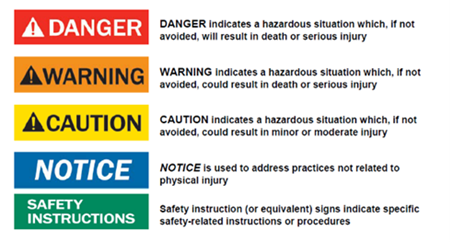
Figure 1
ANSI Standards and Principles of Effective Warning Signs
I. The following ANSI standards are referenced throughout this study:
a. ANSI Z535.2-2011 – American National Standard for Environmental and Facility Safety Signs.
b. ANSI Z535.1-2017 – American National Standard for Safety Colors.
II. Scholarly research articles about effective warning signs are referenced in footnotes and the bibliography.
III. Effective warning signs contain four elements (Figure 1):
a. Signal Word
b. Type of hazard
c. Consequence of not avoiding the hazard
d. How to avoid the hazard
IV. A Signal Word is a word in large, bold, capital letters at the top of the sign that alerts the reader to the purpose of the sign. Figure 1 shows the standard Signal Words with definitions of each word and consequences if ignored, according to ANSI Z535.2-2011, and in the standard color for each, per ANSI Z535.1-2017.
V. The exclamation point in a Triangle (Figure 2) is the Safety Alert Symbol sometimes added at the beginning of a Signal Word. The Safety Alert Symbol is used to alert people to potential physical injury hazards and to obey all safety messages that follow the symbol to avoid possible injury or death.
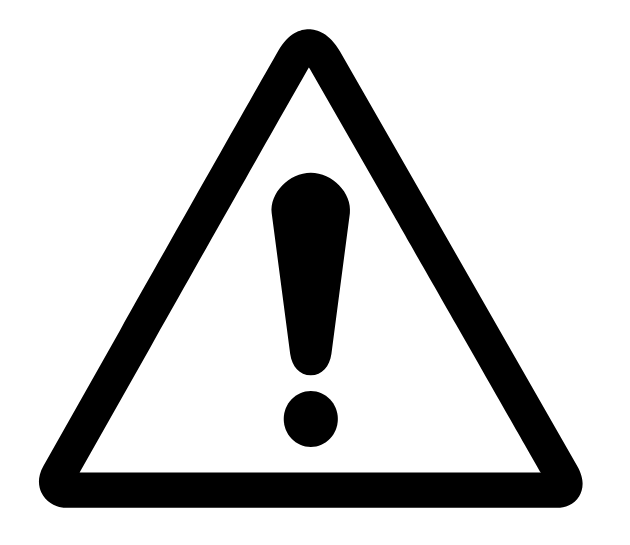
Figure 2
VI. Warning signs may be arranged in a variety of ways, including horizontal and vertical. Regardless of arrangement, the Signal Word should be at the top. The essential information about the type of hazard, consequence of not avoiding the hazard, and how to avoid the hazard may be conveyed by a word message, symbol(s), or both, in ANSI Z535.2-2011 (Figure 3).
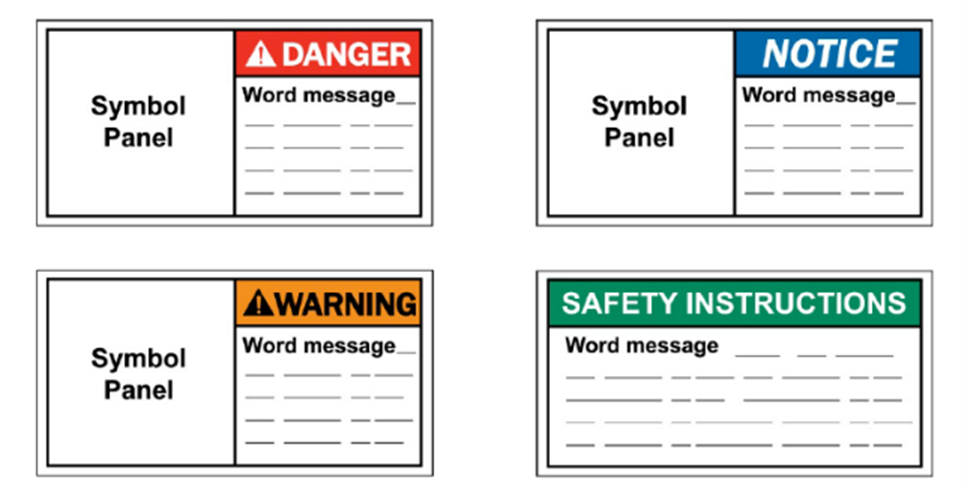
Figure 3
ASTM International Volume 15.07: Amusement Rides and Devices
ASTM International amusement standards are found in ASTM Volume 15.07 Amusement Rides and Devices and are created, developed, and revised by Committee F24. ASTM Committee F24 was established in 1978 and is made up of industry insiders, technical experts, attorneys, and other interested parties. What follows is a review of the requirements for instructional and warning signage found in three ASTM amusement ride standards.
Requirements for Signage and Warnings
Amusement operators often use shared words and pictograms to warn patrons with various maladies that they should not participate in a particular attraction, such as preexisting medical conditions, circulatory conditions, heart or lung conditions, recent surgeries, back or neck conditions, high blood pressure, spine, musculoskeletal or head injury, and pregnancy. I am not aware of scientific research into the effects of amusement rides on the aforementioned conditions, and it seems a commonsensical rather than scientific approach. Nonetheless, these conditions are typically listed on informational amusement attraction signs and passed off as warnings to patrons. The ASTM amusement standards do not specify what a warning should look like, nor are there prohibitions for specific bodily conditions. The exception to this is the trampoline standard below.
ASTM F770-23 Standard Practice for Ownership, Operation, Maintenance, and Inspection of Amusement Rides and Devices includes requirements for signage in Section 6.4, Patron Communication.
It requires that signs be prominently placed and that information presented be concise and bold in design. It states that instructions may include height and/or health requirements and patron duties. Lastly, it requires posted warnings at entrances to restricted areas. There is no further guidance regarding the design of signs or use of instructional or warning language.
ASTM F2291-23 Standard Practice for Design of Amusement Rides and Devices, Section 6.7 Signage states that the manufacturer may make recommendations about appropriate instructional or warning signs and that the wording should be clear and concise.
ASTM F2970-22 Standard Practice for Design, Manufacture, Installation, Operation, Maintenance, Inspection and Major Modification of Trampoline Courts includes requirements for instructional/warning signage in Section 7.14 Signage; Section 15 Manufacturer Responsibilities; and specific educational signage requirements for particular types of attractions in Sections 7.8 and 7.24. The requirements in subsection 7.14 are almost identical to the signage requirements in ASTM F770-23 and ASTM F2291-23. Subsection 15.6 requires manufacturers to determine recommended warnings about forces that could aggravate various physical conditions.
ASTM F2970-22 is unique among the ASTM amusement standards in that it contains examples of signs in its non-mandatory appendix. While the ANSI Z535 standards for warning signs are not referenced, some of the example signs provided do conform to ANSI standards (Figure 4).
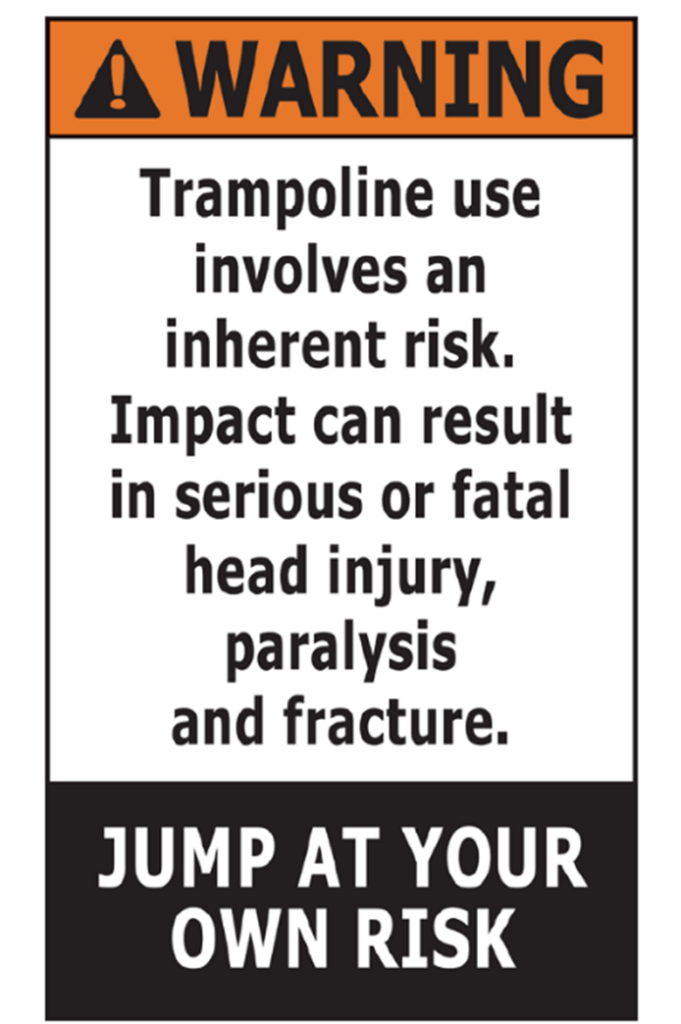
Figure 4
Summary of Findings
The ASTM amusement standards contain requirements for “patron communication” as it relates to signs which include warnings, but more instruction is provided for placement than what an effective warning should look like or include. Often the signal word WARNING is not mentioned, and so much information is offered that any perceived warning gets lost within copious information.
Moreover, none of the ASTM amusement standards require compliance with ANSI Z535, and other than their vague requirement that signs be “concise and bold,” the ASTM amusement standards are not instructive to amusement industry professionals regarding design of effective warning signs. ASTM F2970-22, the trampoline standard, comes closest to providing helpful guidance by providing example signs that comply with ANSI standards; however, it fails to reference the ANSI Z535 standards or require its compliance.
Amusement industry owner/operators should make decisions about their intended use and effectiveness of warnings and instructional signage. If actual warnings are intended to alert patrons to hazards and potential harm, ANSI Z535 would be the place to look for improvement.
Warning signs that comply with ANSI Z535 are designed to stand out, which is in opposition to what a sign designer may consider aesthetic or, worse, information overload. Since human factors studies conclusively show that people often ignore signs, even to their detriment, warnings should include the signal word “WARNING” and be “bold and concise,” as suggested by both ASTM and ANSI.
¹ ANSI Z535.1-2017
² Wogalter & Laugher, 1996
³ Laughery & Wogalter, 2006
⁴ Wogalter, et al., 1987
⁵ Laughery & Wogalter, 2006

